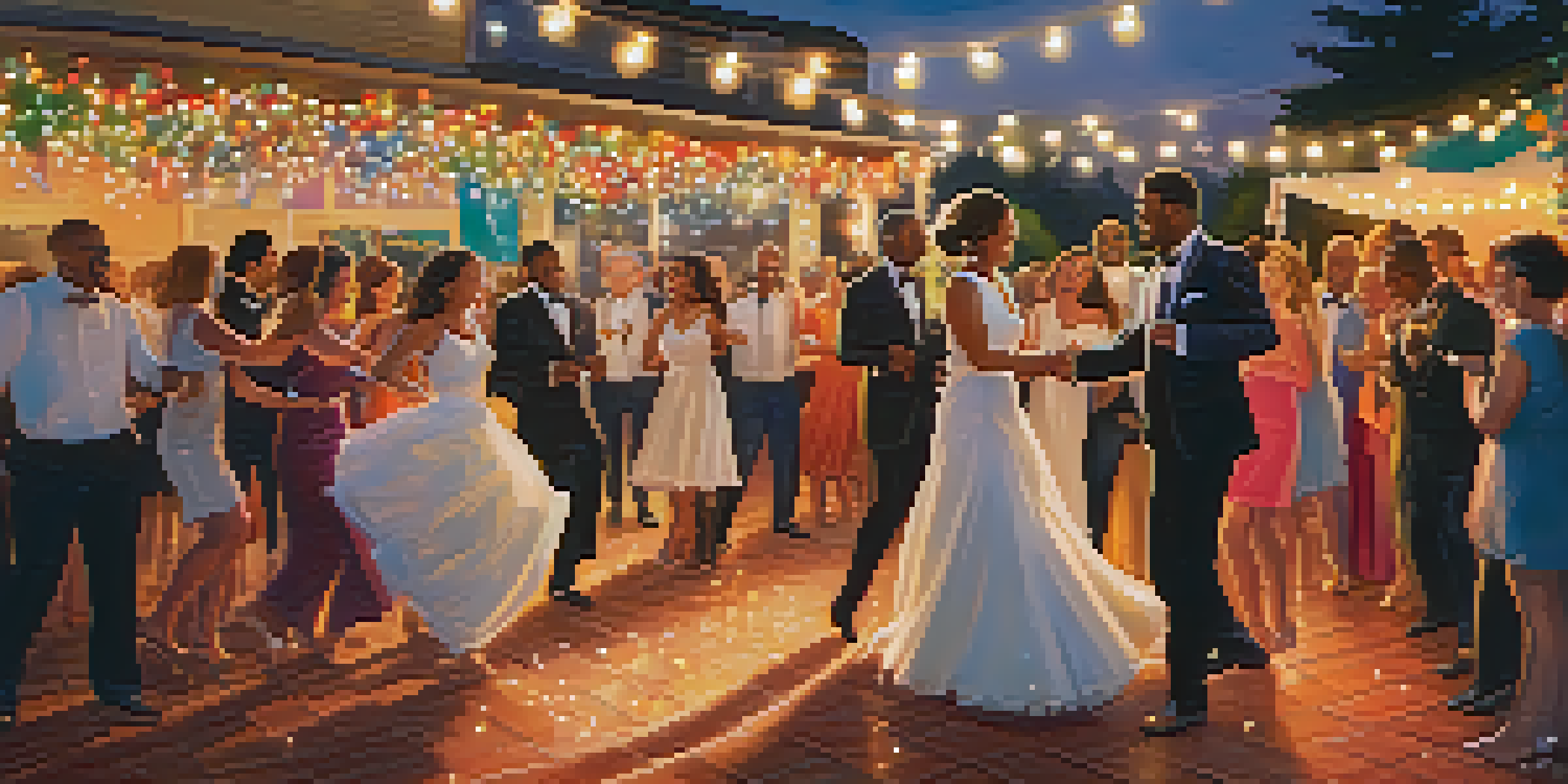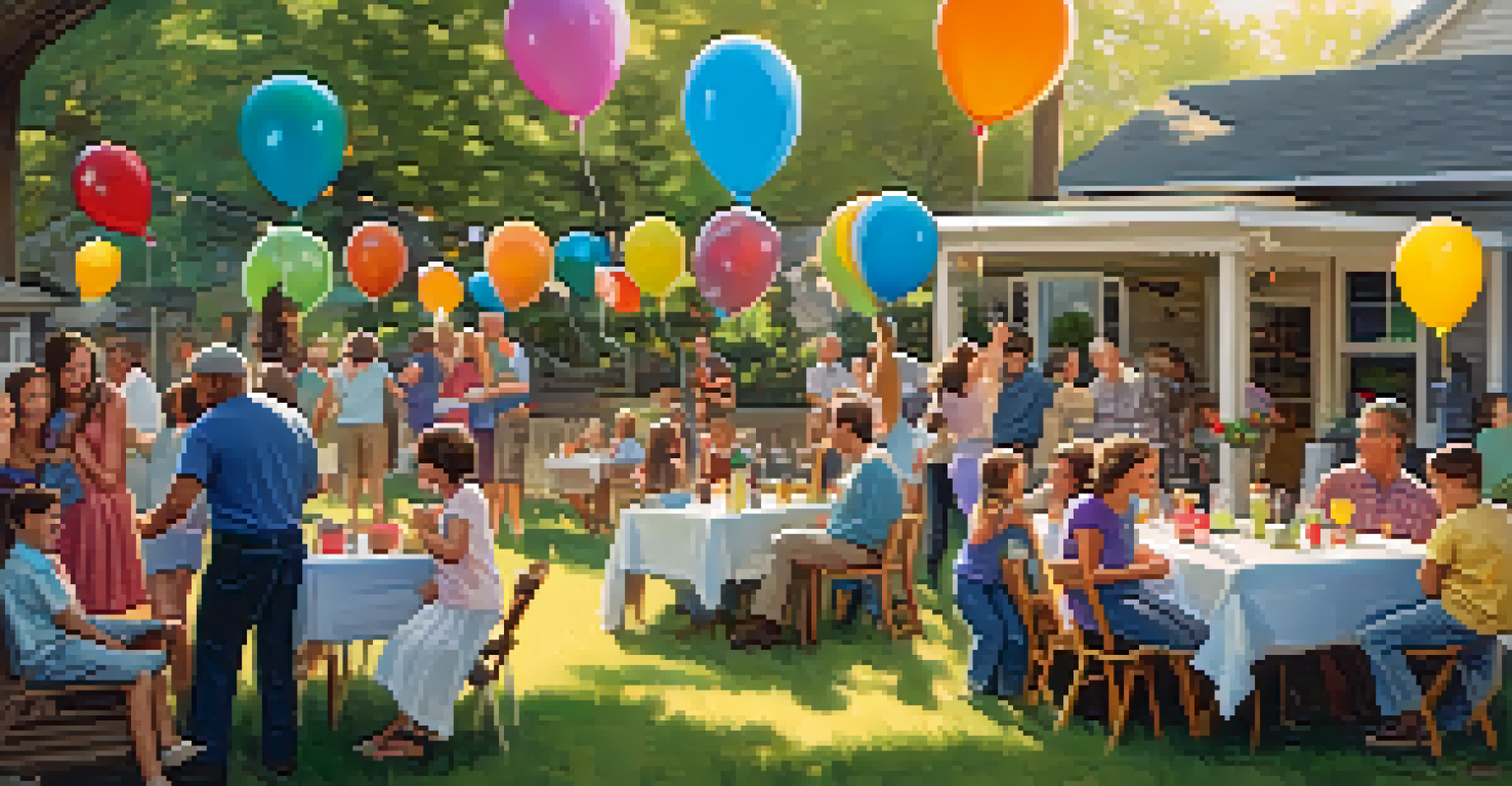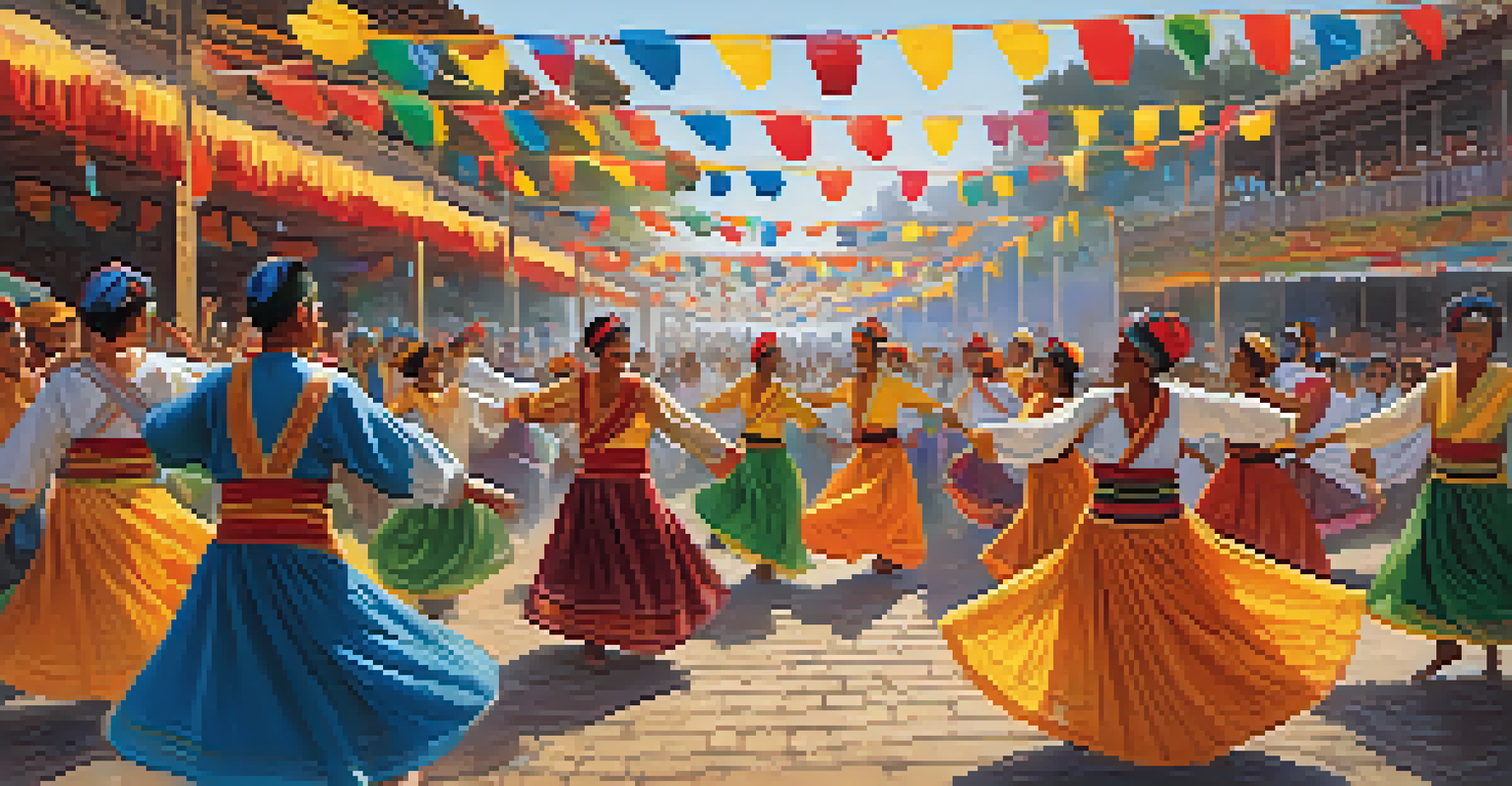The Role of Dance in Social Events: Celebrations and Gatherings

Dance as a Universal Language in Social Events
Dance transcends cultural barriers, acting as a universal language that brings people together. Regardless of age, background, or nationality, the act of moving rhythmically can create a shared experience that fosters connection. For example, at weddings, you’ll often find guests from various walks of life dancing together, united by the joy of the occasion. This spontaneous celebration highlights how dance can bridge differences, making it an essential component of social events.
Dance is the hidden language of the soul.
Moreover, dance allows individuals to express emotions that words sometimes cannot capture. Whether it's the joy of a celebration or the sorrow of a farewell, movement conveys feelings in a visceral way. Consider how at a birthday party, the dance floor becomes a canvas for laughter, excitement, and even nostalgia, as people reminisce about past celebrations. Such emotional expression enhances the overall atmosphere, making events memorable.
Ultimately, dance cultivates a sense of belonging among participants. When everyone joins in, it creates an inclusive environment where guests feel connected to each other and the event itself. This feeling of community is especially palpable during group dances, where the collective energy lifts spirits and encourages participation. In this way, dance is not just an activity; it's a vital ingredient for meaningful social interactions.
Creating Lasting Memories Through Dance
One of the most beautiful aspects of dance at social events is its ability to create lasting memories. Think about the last family reunion you attended; chances are, the dances shared during that gathering are etched in your mind. These moments, filled with laughter and joy, become stories that get retold for years, connecting generations. Dance not only marks the occasion but also solidifies relationships through shared, joyful experiences.

For instance, at milestone celebrations like anniversaries or graduations, families often engage in special dances that symbolize their journey together. These choreographed moments can be both poignant and celebratory, allowing participants to reflect on their shared history. As guests watch or join in, they become part of a narrative that intertwines their lives with those of others, further deepening connections.
Dance Unites Across Cultures
Dance serves as a universal language, fostering connections among people of diverse backgrounds during social events.
Moreover, the magic of spontaneous dance often leads to unexpected, joyful moments that become part of the fabric of the event. When a catchy song plays and everyone rushes to the dance floor, the energy shifts, and laughter fills the air. These unplanned dances often lead to some of the best stories, reinforcing the idea that the best memories are often made when we least expect them.
Dance as a Tool for Cultural Expression
Throughout history, dance has served as an important means of cultural expression, particularly in social gatherings. Different cultures have unique dances that reflect their traditions, values, and stories. For example, at cultural festivals, you might witness traditional folk dances that showcase the community’s heritage, allowing participants to take pride in their roots. This cultural sharing enriches the event, making it a vibrant tapestry of diverse influences.
Dancing is like dreaming with your feet!
Incorporating dance into social events can also be a way to educate attendees about different cultures. When people participate in traditional dances, they gain insight into the customs and stories behind those movements. This not only fosters appreciation but also encourages respect and understanding among diverse groups. A simple dance can spark curiosity and lead to meaningful conversations about cultural heritage.
Furthermore, dance can serve as a unifying force within communities, especially during celebratory events. When everyone gathers to participate in a traditional dance, it creates a sense of collective identity and pride. This shared experience can strengthen community ties and promote a sense of belonging, making events more than just celebrations; they become opportunities for cultural exchange and unity.
The Role of Dance in Building Social Connections
At social events, dance acts as a catalyst for building connections among attendees. When people step onto the dance floor, barriers often drop, allowing for genuine interactions. It’s not uncommon to see strangers become friends over a shared love for dancing, as the rhythm and movement create a playful atmosphere. This communal experience makes it easier for individuals to bond and connect on a more personal level.
Additionally, dance can serve as an icebreaker, especially at events where guests may not know each other well. Inviting attendees to join in a group dance can break the initial awkwardness and encourage mingling. When everyone is moving together, it fosters a sense of camaraderie that can lead to deeper conversations later on. In this way, dance sets the stage for friendships to blossom.
Memories are Made on the Dance Floor
Shared dance experiences at social gatherings create lasting memories that strengthen relationships and community bonds.
Moreover, the memories created on the dance floor often serve as a foundation for future interactions. When people share joyful experiences, it makes them more likely to seek each other out in the future. This creates a ripple effect, where the connections made during one event can lead to new friendships, collaborations, and a stronger sense of community in subsequent gatherings.
Dance as a Form of Entertainment
Dance undeniably adds an element of entertainment to social events, making them more enjoyable for everyone involved. Whether it's a professional performance or a lively dance-off among guests, movement captivates audiences and keeps energy levels high. For instance, at corporate gatherings, hiring a dance troupe can elevate the event, providing a unique form of entertainment that engages attendees and sparks conversations.
Moreover, engaging guests in dance can transform an ordinary event into something extraordinary. When the DJ plays that one catchy song, and everyone rushes to the floor, the atmosphere shifts dramatically. This infectious energy encourages even the shyest individuals to join in, leading to a dynamic and unforgettable experience. Dance, in essence, has the power to uplift spirits and create an enjoyable ambiance.
Additionally, dance competitions or social dance games can serve as a fun way to keep guests entertained. When participants compete for the best dance moves, it fosters a light-hearted atmosphere where laughter and camaraderie thrive. These moments not only entertain but also encourage interactions among guests, making them feel more involved in the event and enhancing their overall experience.
The Health Benefits of Dancing at Social Gatherings
Beyond the fun and connection it provides, dancing at social events offers several health benefits. Engaging in dance can increase physical activity levels, which is essential for maintaining overall health. When guests hit the dance floor, they’re not just having fun; they’re also getting a workout that improves cardiovascular health, flexibility, and coordination. This makes dance a delightful way to promote well-being while celebrating.
Moreover, dancing can also have positive effects on mental health. The act of moving to music releases endorphins, often referred to as 'feel-good' hormones, which can elevate mood and reduce stress. Social dancing allows individuals to escape their everyday worries, even if just for a little while, leading to a more enjoyable experience. In this way, dance becomes not only an entertaining activity but also a form of self-care.
Health Benefits of Dancing
Dancing not only enhances enjoyment at events but also promotes physical and mental well-being through social interaction and exercise.
Additionally, the social aspects of dance contribute to improved mental well-being. Interacting with others on the dance floor can foster a sense of belonging and community, which is vital for emotional health. When people come together to dance, they create bonds that support each other, leading to a more fulfilling social life. This combination of physical activity, joy, and social interaction makes dance a true gift to any event.
The Future of Dance in Social Events
As we look ahead, the role of dance in social events is likely to evolve, especially with the rise of technology and virtual gatherings. While nothing can quite replicate the energy of an in-person dance floor, digital platforms are finding ways to incorporate movement. Virtual dance parties and online dance classes have emerged, allowing people to connect and celebrate from the comfort of their homes. This adaptability highlights dance's enduring significance in social interactions.
Moreover, as cultural influences continue to blend, we may see new dance styles emerging at social events. The fusion of traditional and contemporary dance forms can create unique experiences that reflect our diverse world. For instance, a wedding might blend a classic waltz with popular music, allowing for a celebration that honors tradition while embracing modernity. This evolution keeps dance fresh and relevant, appealing to a wide range of attendees.

Finally, as we navigate a post-pandemic world, the importance of dance in social events may take on new meaning. After a period of isolation, the desire for connection and shared experiences will likely fuel the revival of dance at gatherings. Whether it’s weddings, birthdays, or corporate functions, dance will remain a vital element that brings people together, reminding us of the joy and community that celebration can foster.